 UK Royal Navy (1902-1921)
UK Royal Navy (1902-1921)E class: 34 ships.
WW1 British Destroyers:
26 knotters | 27 knotters | 30 knotters | 33 knotters | Turbine destroyers | River class | Cricket class | Tribal class | Beagle class | Acorn class | Acheron class | Acasta class | L class | M class | Repeat M class | Medea class | Faulknor class FL | Marksman class FL | Parker class FL | Talisman class | Shakespeare class FL | R class | S class | Repeat R class | V class FL | Scott class FL | V class | W classThe 34 Royal Navy “river” class destroyers were the first built with a forecastle, on the same admiralty specifications issued to six yards previously involved in the 27 and 30 knotters. Despite the fact turbine destroyers were tested shortly before, only one on the whole had turbines for comparative tests. They came from Palmer (9), Yarrow (5), Hawthorn Leslie (6), Laird (7), Thornycroft (4), and White (2). All diverged between class built along the order years. They were known as the River class since all were named after British rivers, yet they became collectively in 1912 the E class and they actively served in WWI.
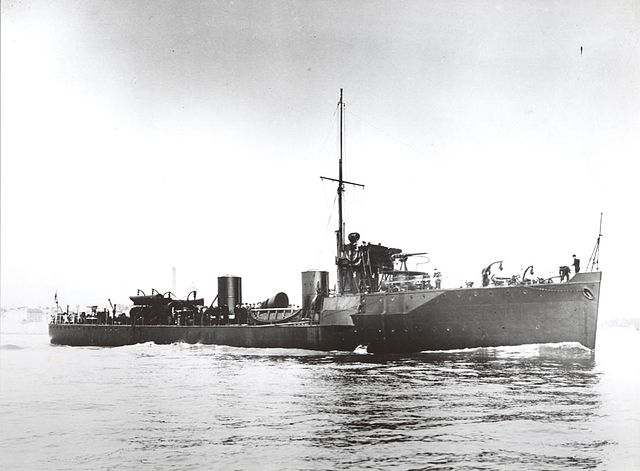
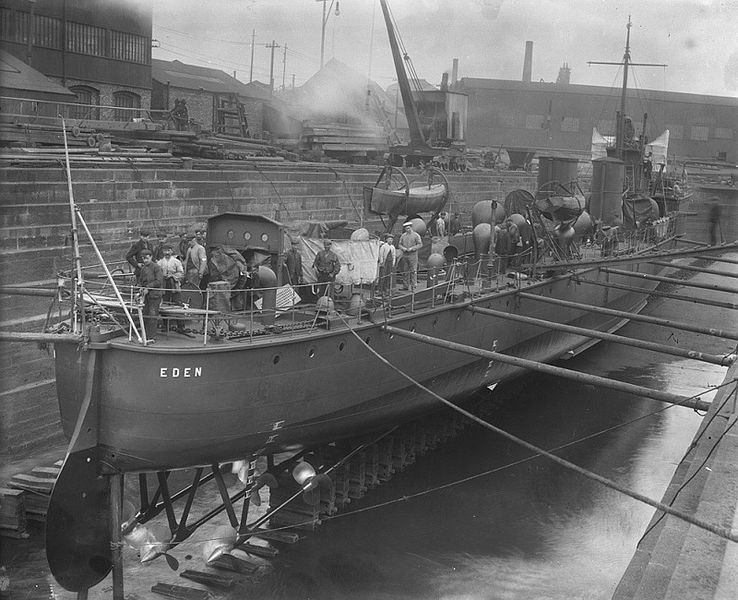

HMS Eden, Hawthorne Leslie. She had turbines unlike her sister Derwent for comparisons, three shafts and six props.
Development
The River class are generally considered as the true break between torpedo boats and proper destroyers, and the first modern ones, putting Britain and the Royal Navy in the lead on this topic. This was reassuring for some in the admiralty, notably admiral “Jackie” (John Arbuthnot) Fisher, admiral of the Mediterranean fleet until 1902 and by early June appointed as Second Naval Lord. He saw first hand the mass of French torpedo boats and the potential threat they posed (of that of Germany, Italy, the Austro-Hungarian Empire for that matter). However early torpedo boat destroyers, pioneered by Spain and later derived from larger TB types had seaworthiness, speed and range issues. Not only traditional triple expansion steam engine had apparently reached the limits of their capabilities, proved unable to deliver 33-34 knots, but in heavy weather the speed and range fell dramatically as the ships with their turtleback prow struggled to stay stable, rolling, pitching and generally fighting the waves before even trying to catch on the enemy.
Initial request

Strangely the initial official request did not came from the North Sea but from the Mediterranean, and not from Fisher but Commander John Michael de Robeck which in December 1900 in his quality of senior destroyer officer in the fleet, for a new class of destroyer with longer range, better sea-keeping qualities than the 27 and 30-knotters. His specifications were for a range of 1,650 nmi (3,056 km) and sustained, cruise speed of 18 knots (33 km/h). He pointed out the 30-knotters were only capable of 1,400 nmi (2,593 km) at 13 knots (24 km/h).
He said nothing about top speed as recoignized meaningless. He suggested modifications to make these more seaworthy, notably in adverse weather conditions, the raised forecastle feature in place of the turtleback forward of the bridge being essential. He also asked to have the bridge placed further aft to avoid sea spray from the bow. He also asked that all destroyers should run their their speed trials with a realistic combat load. This was done not for the “30-knotter” but the 33 knotters and the three prototype turbine destroyers. This was revealing as the latter might have impressive top speeds, vut failed completely to sustain it in adverse conditions at full load while their range was even worse.
He was conformed in this by many other destroyers officers of the Home Fleet. Vice-Admiral “Jackie” Fisher, always keen to stay informed of foreign design, supported this by the comparison taken on the German S90-class torpedo boat and their “toothbrush” hull, impressing RN officers.
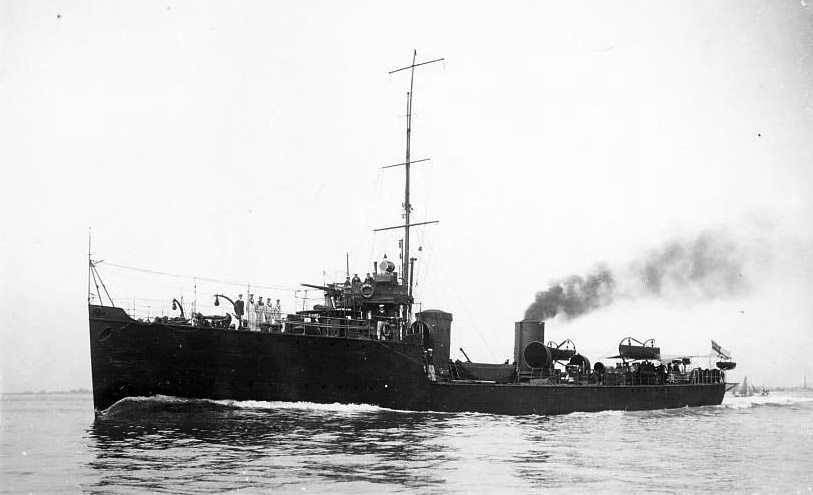
HMS Kale on trials (H. leslie)
Experience with earlier types of destroyer had shown quite clearly that concentrating on high trial (in smooth water) speed was a snare and delusion. The combination of seaworthiness with the ability to maintain a less spectacular speed when it became rough was of far more real value. The early destrovers were too lightly built, too small and too delicate to be fully effective in all conditions as fighting ships. The lesson was underlined by the success of the German S90 class which had a raised forecastle and proved very seaworthy. The Admiralty decided therefore to ask for more heavily built destroyers with raised forecastles and a contract speed of only 25skts. The larger size and sturdiness of the new design was correctly held to allow the new destroyers to maintain this speed in most conditions when the earlier destroyers dropped well below it.
Design work and evaluation
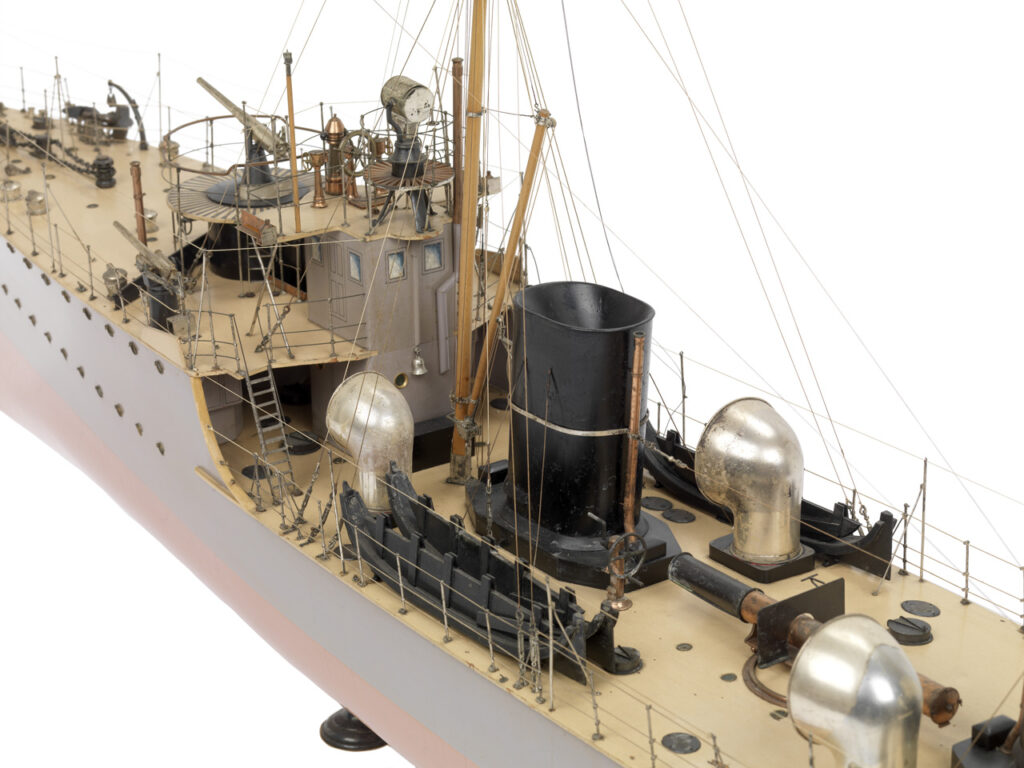
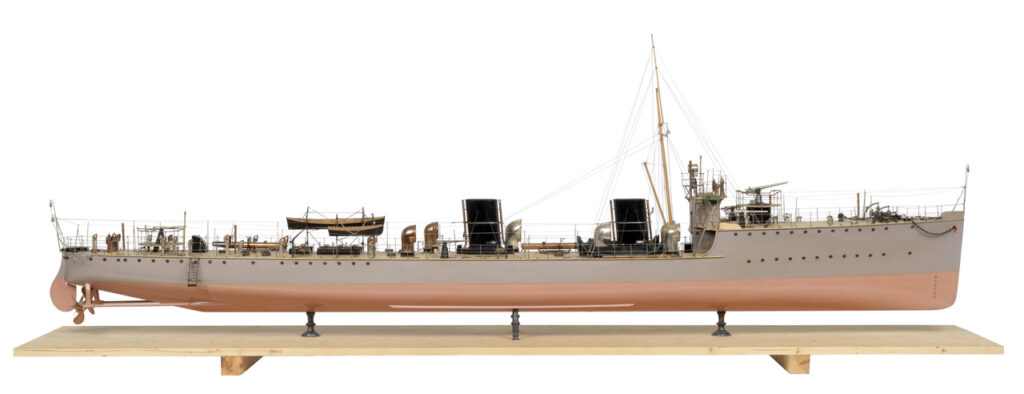
In July 1901 the Director of Naval Construction (DNC) started to worked on sketch designs including most features de Robeck advocated. But he also insisted on having a heavier and more reliable engine (neither VTEs pushed to the extreme or not mature turbines). Trials speed was setup by advance as 27 knots (50 km/h), further requirements had ot toned down to a lackluster 25.5 knots (47.2 km/h), a far cry from the unrealistic 30-33 knots. This caused concerns by other in the admiralty feating they would not be able to catch 33 knot capable torped boats. That speed was however perfectly realistic and measured with a 95 tons coal load. This was compensated by better sea-keeping properties making these ships performing in any seas instead of just flat calm.
The raised forecastle proved a particularly desirable feature as it enabled speed to be kept up when Steaming into waves and also allowed the forward guns to be fought in comparatively bad conditions, besides keeping the watchkeepers much drier. The latters’ condition was much improved anyway by being given a bridge. The armament of this class was identical to the 30-knotters, teh forward 6-pdr being sponsoned out of on either side of the forefunnel in the first group. However this made their positions somehwat wet in a head so in the 1902/3 group and sebsequent ships they were moved up to either side of the 12 pdr on the forecastle. Experienced in the Russo-Japanese war showed that the 6 pdr was too light to have a real effect and in 1906 it was decided to replaced the 6-pdr for 12-pdr, thererby giving a total of 4-12 pdr as well as the 2-18 in TT.
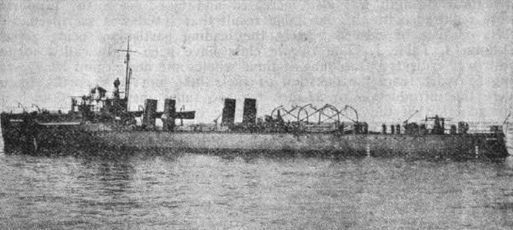 These vessels marked the real break between the torpedo boat and the true destroyer, and set the pattern for destroyer development both in Britain and most foreign countries until the ‘V & W’ class of the latter part of the 1914-18 war. One, the Eden, was given turbine propulsion. The class gave good service, being used in the First World War on patrol and escort duties. They had been designated ‘E’ class in 1912. They were generally considered less easy to manoeuvre than earlier destroyers, and much more visible thanks to their higher silhouette and therefore less suited to
These vessels marked the real break between the torpedo boat and the true destroyer, and set the pattern for destroyer development both in Britain and most foreign countries until the ‘V & W’ class of the latter part of the 1914-18 war. One, the Eden, was given turbine propulsion. The class gave good service, being used in the First World War on patrol and escort duties. They had been designated ‘E’ class in 1912. They were generally considered less easy to manoeuvre than earlier destroyers, and much more visible thanks to their higher silhouette and therefore less suited to
surprise torpedo attacks. Their lower smooth water speed caused them to be the target of much ill-informed public criticism, but experience showed just the how ignorant this criticism was, as effective speed was so much better. All had a speed of 25-1/2kts (the fastest trials being Eden and Gala with 26.5kts) and were armed with 1-12pdr, 5-6pdr and 2-18in TT. The complement was 70.
The Palmer boats had four funnels in two close groups. 1901/2 Programme.
Design
Hull and general design

By default of finding plans here are thiose of the Para class destroyers ordered by Brazil in 1907 on plans derived from the River class. Built 1908-1910, still active WW2. They also were named after rivers.
The Admiralty in its construction and order process did not changed the rules much (but for trials) and invited private specialist specialist yards to submit their own design based on these new specification. The true challenge here was not to create a forecastle but still finding a way to encased a powerful machinery into a still small hull. Each yard had its own hull and internal arrangements differring, between their own ships creating sometimes three separate classes for each yard. There were not more than ships identical at a time.
The raised forecastle was of course the true innovation and instead of digging in to the sea, it was cutting though it. Turtleback bows created a mass of water spray in heavy weather, wetting the bridge and conning tower as well as the guns. So not only the bridge was raised one deck due to the forecastle, but it was also pushed further back to stay mostly dry at all times.
The S-90 bow type was not chosen, as it was short and still low, more a wave breaker than a practical feature. In the river’s case, it was to provide some added buyancy as well to ride the waves it could not cut trhough, and thus, had a full deck height, also enabling better internal arrangements and comfort for the crew.
The ships all fell into the same average tonnage and size frame, 550 tonnes standard being the norm for all, with diverging fully loaded displacement figures of 615-620 tonnes fully loaded.
In dimensions, 68.58 meters (225 ft) was the shortest lenght overall (Thornycroft boats), 71.14 (233 ft) the longest (Palmer Boats) with beams ranging from 7.16 to 7.28m (23-1/2 to 23ft 10in) and for draft, from 2.74m (9ft) to 2.97m (9-1/2 ft). See the classes for more.
Powerplant
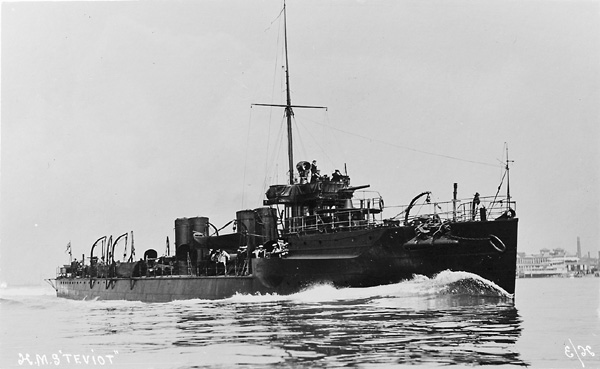
All ships were coal fired, except HMS Arno, oil-fired but she was a much delayed River class. On the 32 built, 28 had triple expansion steam engines and four (HMS Eden, Stour, Test and Arno) had steam turbines. Eden had turbines for comparative tests in the wake of previous experimlental boats (Viper, Cobra, Python (Velox)) to test their viability on a forecastle destroyer. The difference in formula was the adoption of two propellers on each of the three shafts as seen before, to cope with the issue of high revolutions of the drive turbines inherited by Turbinia. Stour, Test were “repeat river” by Cammell Laird. They were purchased after the loss of Gala and Blackwater. Arno was a River class design built by Ansaldo for the Portuguese Navy and launched in 1914. She was purchased by the RN in March 1915 while outfitting at Genoa for obscure reasons and served in the Dardanelles Campaign.
Armament
At first in 1902, the armament was a repeat of the 33 knottes: Single 12-pdr on the forecastle, and four 6-pdr, two single trainable torpedo tubes.
By 1906 the Russo-Japanese War shown how much the 6-pounder was weak, all-6-pounder were replaced by three additional 12-pounders, creating an “all big gun” armament which mirrored HMS Dreanought. No change for the torpedo tubes, which had a reload each but stayed single.
Main: QF 12-pounder 12 cwt naval gun
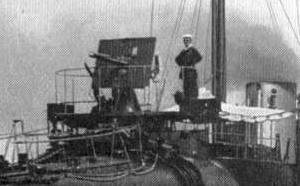 The QF 12-pounder 12 cwt naval gun was brand new when the 26-knotters were in construction, enterering service in 1894. On the River class, instead of a raised platform overlooking the foredeck above the conning tower and forward of the bridge covered in canvas, it was now one deck higher and further aft on a forecastle deck. This left more space for operations and less water spray.
The QF 12-pounder 12 cwt naval gun was brand new when the 26-knotters were in construction, enterering service in 1894. On the River class, instead of a raised platform overlooking the foredeck above the conning tower and forward of the bridge covered in canvas, it was now one deck higher and further aft on a forecastle deck. This left more space for operations and less water spray.
Soon, three more were added, two on either side of the forward gun and one aft. Depending on the design, these lower deck guns had bulwark and hull recesses or not.
These 0.6 tons (510 kg) ordnance saw a career up to 1945, 8,000 delivered. Also produced in Italy and Japan.
Specs:
Separate-loading QF round, caliber 7.62 cm, with a single-motion screw breech.
Rate of fire was 15 rounds per minute, at 2,210 ft/s (670 m/s)
Effective range of 11,750 yd (10,740 m) at 40° for the latter version.
Secondary: 3-5 QF 6-pdr Hotchkiss
The 1883 Hotchkiss et Cie licenced by Elswick were light QF guns still envisioned for the River class. However they were weak after 1906 replaced by 12-pdr on the class.
Specs:
Weight 821–849 lb (372–385 kg), shielded
25 rounds per minute, 57x307R 57-millimetre (2.244 in), 1,818 feet per second (554 m/s)
Vertical sliding-block breech, 4 inch hydro-spring recoil
Range 4,000 yards (3,700 m)
Torpedo Tubes
The Type used was likely the 18-inches Whitehead (45 cm) type, developed in 1888, and introduced as the 26-27 knotters were completed in 1894:
They weighted 845 lbs. (383 kg) for 140 in (3.556 m) in length, with an explosive charge of 118 lbs. (53.5 kg) using wet gun-cotton, single setting, 800 yards (730 m) at 26.5 knots (which was actually slower than the destroyer’s top speed!). It was driven by a three cylinder radial Brotherhood pattern engine, fed by an Air-flask (cold running) of compressed air.
No upgrade as they were ultimately all retired. Both were axial, one admiship and one aft, often before the aftermost funnel, close to the aft steering post, before the stern gun.
Four torpedoes were carried, two already in the tubes, two spares. It was another difference with the previous 30 knotters which had all a fixed bow tube.
Construction Programmes:
1901-02 Programme:
R. W. Hawthorn Leslie & Company, Hebburn: Derwent, Eden
Palmers Shipbuilding and Iron Company, Jarrow: Erne, Ettrick, Exe
Yarrow & Co., Poplar: Ribble, Teviot, Usk
Laird Brothers*: Birkenhead: Foyle, Itchen
1902-03 Programme:
Laird Brothers*, Birkenhead: Arun, Blackwater
Yarrow & Co., Poplar: Welland
R. W. Hawthorn Leslie & Company, Hebburn: Waveney
John I. Thornycroft & Company, Chiswick: Kennet, Jed
Palmers Shipbuilding and Iron Company: Jarrow: Cherwell, Dee, Rother**
*Laird Brothers were taken over by steelmakers Cammell in 1903 and became Cammell Laird & Co.
**Rother was laid down as supplementary hull on speculation but purchased by the Admiralty in 1904, named Rother.
Between the 1901-02 and 1902-03 Programmes the major differences were their forward pair of 6-pdr guns were mounted on sponsons extending outwards abreast of the bridge but on the next programme’s ships they were deleted while the forecastle was extended back as far as the bridge so they were mounted directly on the two sides of the forecastle, which was later retro-fitted on the earlier ships.
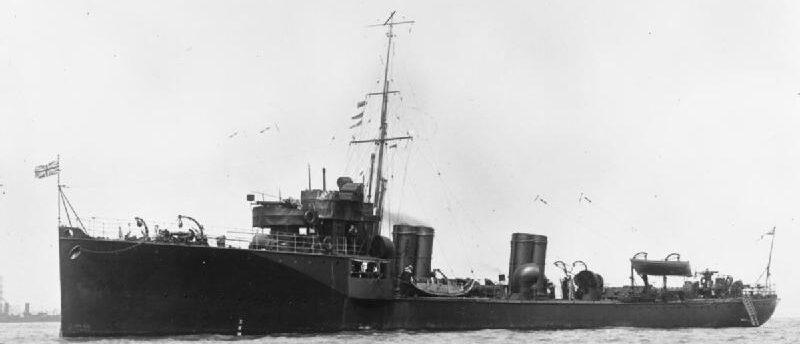
HMS Exe 1903, IWM
1903-04 Programme:
R. W. Hawthorn Leslie & Company, Hebburn: Boyne, Doon, Kale
Palmers Shipbuilding and Iron Company, Jarrow: Swale, Ure, Wear
Cammell Laird & Company, Birkenhead: Liffey, Moy, Ouse
Yarrow & Co., Poplar: Gala, Garry
John I. Thornycroft & Company, Chiswick: Chelmer, Colne
J. Samuel White, Cowes: Ness, Nith
Late purchases:
Cammell Laird & Company, Birkenhead: Stour, Test*
Giovanni Ansaldo & Co, Genoa: Arno**
*Stour and Test built by Cammell Laird on speculation; purchased by the Admiralty in December 1909.
**Portuguese Liz pre-war, purchased by the Admiralty in March 1915, renamed for the river Arno (Portugal).
Classes, specs and Service
On 30 August 1912, the Admiralty wanted all destroyer classes redesignated by alpha characters. The 27-33 knotter were under A to D depening on their funnel numbers, and the River Class were became thus, the E Class. So until 30 September 1913 the letter E was painted on theit hull below the bridge area and fore or aft funnel.
 Palmer ships:
Palmer ships:

HMS Erne in 1903
Eme class (1903): HMS Eme, Ettrick, Exe (four funnels closely paired)
Cherwell class (1903): HMS Cherwell, Dee (four funnels closely paired)
Swale class (1903): HMS swale, Ure, Wear (four funnels closely paired)
Service:
HMS Eme:
East Coast Destroyer Flotilla, 1st Fleet Harwich. April 1909 3rd Destroyer Flotilla Harwich. May 1912 5th Destroyer Flotilla, 2nd Fleet. 1914 9th Destroyer Flotilla Chatham TD HMS St George. Anti-submarine, counter mining patrols, Firth of Forth. Scapa Flow TD HMS King George V. Lost 6 February 1915 (Lt-Cdr John Landon) severe easterly gale, driven ashore NE of Aberdeenshire 800 yards south of Rattray Head lighthouse. Wreck abandoned October 1915, sold for BU.
HMS Ettrick:
East Coast Destroyer Flotilla, 1st Fleet Harwich. April 1909 3rd Destroyer Flotilla Harwich. May 1912 5th Destroyer Flotilla, 2nd Fleet. 191 9th Destroyer Flotilla Chatham TD HMS St George, Firth of Forth. September Portsmouth, Dover Patrol, Dover Barrage. August 1915 1st Destroyer Flotilla Portsmouth, November 1916, 1917 convoy escort 1st Flotilla, English Channel. 7 July 1917 torpedoed by the UC-61, 15 miles SW Beachy Head, 49 officers and men lost, lost bow, towed to port, not repaired, hulked; sold 27 May 1919n BU.
HMS Exe:
China Station late 1904, typhoon off Shanghai. September 1912 refit Sheerness; 5th Flotilla. March 1913, 9th Flotilla Chatham. 1914, 9th Destroyer Flotilla Chatham TD HMS St George, Firth of Forth, Scapa Flow Local Flotilla TD HMS King George V. February 1915 English Channel 6th Flotilla, Dover Patrol, Portsmouth. December 1916 mid-English Channel, Le Havre. Looked for and attacked UC-17. 27 February 1917 spotted UB-40, attacked with paravanes plus P-class P33 attacked DCs, escaped. Night 13/14 May spotted possible sub, attempted to ram, escaped in rain storm. PO 1919, sold 10 February 1920.
HMS Cherwell:
East Coast Destroyer Flotilla, 1st Fleet Harwich. April 1909 3rd Destroyer Flotilla Harwich. May 1912 5th Destroyer Flotilla, 2nd Fleet. Early 1914 9th Destroyer Flotilla Chatham TD HMS St George. August 1915 North Channel Patrol based, Larne, N Ireland, escort, ASW and counter smuggling patrols. November 1916 1st Destroyer Flotilla Portsmouth. Convoy system English Channel 1917-18, PO 1919 sold 23 June 1919.
HMS Dee:
China Station late 1904. September 1905 severe typhoon, no damage. Home Waters 9th Destroyer Flotilla Chatham, Firth of Forth, Scapa Flow Local Flotilla TD HMS St Vincent. August 1915 7th Destroyer Flotilla Humber Patrol til 1918. PO 1919 sold 23 July 1919.
HMS Swale:
China Station late 1905. Home waters early 1914, 9th Destroyer Flotilla Chatham Firth of Forth, August Scapa Flow TD HMS Marlborough. November 1916 1st Destroyer Flotilla Portsmouth. Spring 1917 convoy escort duties, English Channel, PO 1919 sold 23 June 1919.
HMS Ure:
East Coast Destroyer Flotilla, 1st Fleet Harwich. April 1909 3rd Destroyer Flotilla Harwich. May 1912 5th Destroyer Flotilla, 2nd Fleet. Early 1914 9th Destroyer Flotilla Chatham Firth of Forth, Scapa Flow TD St Vincent. North Channel Patrol, Larne, N Ireland escorting duties, counter smuggling patrols after Dublin 1916 uprizing. November 1916 1st Destroyer Flotilla Portsmouth. Dover Barrage, convoy system 1917-18, PO 1919 sold 27 May 1919.
HMS Wear:
China Station late 1905. 2nd Destroyer Flotilla Home Fleet 1907. 12 January 1907 underway to Portland collided with merchant Etna off Beachy Head, badly damaged, repairs Portsmouth, and Sheerness. 17 July 1913 North Sea Fishery Protection Flotilla (prov.). Refit at Gibraltar, local patrol force September 1914. March 1915 Straits patrol. Dardanelles Campaign, escort duties. Rescue on 18 March 1915 (28 officers and 582 men) HMS Irresistible. 5 July 1915 Smyrna Patrol, based Mytelene. Skyros 16 April 1915 chased off, destroyed Turkish torpedo boat Demir Hissar attacking SS Manitou at Tribouki. 1 January 1917 shelled Yuk Yeri Bay. 1919 Home Waters, PO, sold 4 November 1919.
HMS Rother:
East Coast Destroyer Flotilla, 1st Fleet Harwich. January 1909 refit Sheerness, Eastern Flotilla Harwich. April 1909 3rd Destroyer Flotilla Harwich, 2 November 1909 collided with HMS Crusader off Longsand lightvessel. Repaired Harwich. May 1912 boilers retubed Pembroke Dockyard, 5th Destroyer Flotilla, 2nd Fleet. March 1913 9th Destroyer Flotilla, Nore.
Northern East coast 1915. June 1915 Portsmouth until August 1917, 7th Destroyer Flotilla, convoy escort duties East coast September 1917. February 1918 Portsmouth 1st Destroyer Flotilla. PO May 1919 sold 23 June 1919.
⚙ HMS Ribble specifications |
|
| Displacement | 590 long tons standard, 660 long tons (671 t) full load |
| Dimensions | 231 ft 4 in x 23 ft 6 in x 7 ft 2.5 in (70.51 x 7.16 x 2.197 m) |
| Propulsion | 2× VTE, 4× Yarrow type water tube boilers 7,000 shp (5,200 kW) |
| Speed | 25.5 kn (47.2 km/h) |
| Range | 130 tons coal, 1,620 nmi (3,000 km) at 11 kn (20 km/h) |
| Armament 1902 | 1× QF 12-pdr 12 cwt Mark I, Mt P Mark I, 5× QF 6-pdr 8 cwt, 2× 18-in (450 mm) TTs |
| Armament 1906 | 1x QF 12-pdr 12 cwt+ 3×8 cwt mot G Mark I, 5× QF 6-pdr 8 cwt, 2× 18-in (450 mm) TTs |
| Crew | 70 officers and ratings |
 Yarrow ships:
Yarrow ships:

Four funnels openly paired, fwd gun at deck level.
Ribble class: HMS Ribble (launched 19 March 1904), Teviot (launched 7 November 1903), Usk (launched 25 July 1903) four funnels openly paired and with no raised piece in the eyes.
Welland class: HMS Welland (launched 14 April 1904)
Gala class: HMS Gala* (launched 7 January 1905), Garry (launched 21 March 1905).
*collided with HMS Attentive and sank 27 April 1908 off Harwich.
Service:
HMS Ribble:
East Coast Destroyer Flotilla, 1st Fleet Harwich. 27 April 1908 night manoeuvres, cruiser Attentive rammed and sank Gala and collided with Ribble. Repairs Sheernes.
1909-1910 China Station. July 1914 China Station, Hong Kong, Tdr HMS Triumph. Patrol duties. Redeployed 5th Destroyer Flot. Mediterranean Fleet November 1914. Dardanelles Campaign. 17 March 1915, assisted FR BB Bouvet (struck a mine). 25 April 1915 supported landings ANZAC Cove. February 1916 Smyrna Patrol, HP Port Iero, Lesbos. 1919 returned home, paid off reserve. Sold 29 July 1920 BU.
HMS Teviot:
East Coast DD Flotilla, 1st Fleet Harwich. April 1909 3rd Destroyer Flotilla, 1st Fleet Harwich. May 1912 5th Destroyer Flotilla, 2nd Fleet. 1914 9th Destroyer Flotilla Chatham Tdr HMS St George. ASW Patrol, Ct. mining patrols, Firth of Forth. September 1914 Portsmouth, Dover Patrol. August 1915 1st Destroyer Flotilla Portsmouth, equipped with DCs, Dover Barrage. Convoy escort duties til Nov.1918, sold 1919.
HMS Usk:
East Coast DD Flotilla, 1st Fleet Harwich. 1909-1910 China Station. July 1914 China Station HK TD HMS Triumph, Tsingtao blockade til November 1914. 5th Destroyer Flotilla Med Nov 1914, Dardanelles campaign. 25 April 1915 supported landings ANZAC Cove. 22 May 1915 escorted HMS Canopus Malta-Mudros. February 1916 Smyrna Patrol, blockade, HP Port Iero, Mytelene. 17-18 February 1916, operations at Khios. 1918 back home, PO reserve, sold 1919.
HMS Welland:
East Coast DD Flot. 1st Fleet Harwich. 1909/1910 China Station to July 1914 Td HMS Triumph, blockade Tsingtao, 5th Destroyer Flotilla Med Nov. 1914, Dardanelles Campaign. 25 April 1915 Smyrna blockade. 5 July 1915 Smyrna Patrol, HP Lesbos. March 1917 escort Malta-Souda. April 1917 dry dock Malta refit. Mudros patrol til 1918. Sold 1920.
HMS Gala:
East Coast DD 1st fleet Harwich. 27 April 1908 trained by night with scouts HMS Adventure, HMS Attentive. Collision with HMS Attentive (rammed after part of engine room), cut in two. All the crew was saved except 1. Fore section sank after being towed into shallow water.
HMS Garry:
East Coast DD Flotilla 1st Fleet Harwich. April 1909 3rd Destroyer Flotilla Harwich. 5th Destroyer Flotilla, 2nd Fleet 1912. 9th Destroyer Flotilla Chatham, ASW Patrols Firth of Forth, Scapa Flow Td HMS Orion. 23 November 1914 spotted and rammed U-18 attempting to enter Scapa Flow, 22 survivors POW. August 1915 1st Destroyer Flotilla Portsmouth November 1916. Dover Barrage, escorts, English Channel til 1918. 19 July attacked UB-110 off Yorkshire, damaged, surfaced, rammed. Collision with HMS Attentive 1919, not repaired. sold 22 October 1920.
⚙ Yarrow specifications |
|
| Displacement | 590t/600t FL |
| Dimensions | 231 ft 4 in x 23 ft 6 in x 7 ft 2.5 in (70.51 x 7.16 x 2.197 m) |
| Propulsion | 2× shafts VTE, 4× Yarrow WT boilers, 7,000 shp (5,200 kW) |
| Speed | 25.5 kn (47.2 km/h) |
| Range | 130 tons coal, 1,620 nmi (3,000 km) at 11 kn (20 km/h) |
| Armament 1902 | 1× QF 12-pdr 12 cwt Mark I, Mt P Mark I, 5× QF 6-pdr 8 cwt, 2× 18-in (450 mm) TTs |
| Armament 1906 | 1x QF 12-pdr 12 cwt+ 3×8 cwt mot G Mark I, 5× QF 6-pdr 8 cwt, 2× 18-in (450 mm) TTs |
| Crew | 70 officers and men |
 Hawtorn Leslie ships:
Hawtorn Leslie ships:

Derwent, Eden, Waveney launched 1903 – Boyne, Doon, Kale launched 1904.
Service
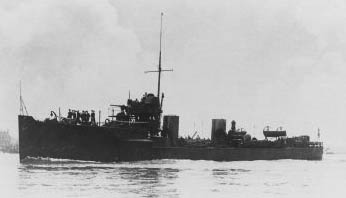 Derwent:
Derwent:
East Coast Destroyer Flotilla, 1st Fleet Harwich. April 1909 3rd Destroyer Flotilla Harwich. May 1912 5th Destroyer Flotilla, 2nd Fleet. Early 1914 9th Destroyer Flotilla Chatham TD HMS St George, Firth of Forth. September 1914 Dover Patrol, Portsmouth. 1st Destroyer Flotilla Portsmouth November 1916. Spring of 1917 convoy system English Channel. 2 May 1917 struck a contact mine from UC-26, off Le Havre, sank north of Whistle Buoy, 58 officers and men lost.
Eden:
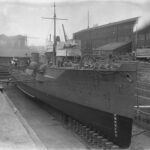 Completed June 1904 with Parsons turbines, 26.2 knots (48.5 km/h; 30.2 mph) trial, fastest of the class. East Coast Destroyer Flotilla, 1st Fleet Harwich. Many test runs compared to HMS Waveney. April 1909 3rd Destroyer Flotilla Harwich. May 1912 5th Destroyer Flotilla, 2nd Fleet. 28 January 1910 (Lt Oliver M F Stokes) broke loose from moorings (bad weather) sank at the Harbour Jetty, East Cliff at Dover. Refloated 30 January, repaired. Early 1914 9th Destroyer Flotilla Chatham TD HMS St George, Firth of Forth. September 1914 Dover Patrol, Portsmouth. Night 18 June 1916 collided with transport SS France English Channel. Sank with Cpt. Lt. A C N Farquhar and 42 crew. 33 rescued. Lays off Fécamp.
Completed June 1904 with Parsons turbines, 26.2 knots (48.5 km/h; 30.2 mph) trial, fastest of the class. East Coast Destroyer Flotilla, 1st Fleet Harwich. Many test runs compared to HMS Waveney. April 1909 3rd Destroyer Flotilla Harwich. May 1912 5th Destroyer Flotilla, 2nd Fleet. 28 January 1910 (Lt Oliver M F Stokes) broke loose from moorings (bad weather) sank at the Harbour Jetty, East Cliff at Dover. Refloated 30 January, repaired. Early 1914 9th Destroyer Flotilla Chatham TD HMS St George, Firth of Forth. September 1914 Dover Patrol, Portsmouth. Night 18 June 1916 collided with transport SS France English Channel. Sank with Cpt. Lt. A C N Farquhar and 42 crew. 33 rescued. Lays off Fécamp.
Waveney:
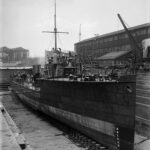 East Coast Destroyer Flotilla, 1st Fleet Harwich. 1906 1st Destroyer Division, 26 July 1907 collided with Garry collided off Sandown. April 1909 3rd Destroyer Flotilla Harwich. May 1912 5th Destroyer Flotilla, 2nd Fleet. Early 1914 9th Destroyer Flotilla Chatham TD HMS St George, Firth of Forth. 16 December 1914 with flag hms Doon, as well as Test, Moy were patrol off Hartlepool, German battlecruiser raid. Undamaged. August 1915 7th Destroyer Flotilla Humber Patrol. PO 1919 sold 20 February 1920.
East Coast Destroyer Flotilla, 1st Fleet Harwich. 1906 1st Destroyer Division, 26 July 1907 collided with Garry collided off Sandown. April 1909 3rd Destroyer Flotilla Harwich. May 1912 5th Destroyer Flotilla, 2nd Fleet. Early 1914 9th Destroyer Flotilla Chatham TD HMS St George, Firth of Forth. 16 December 1914 with flag hms Doon, as well as Test, Moy were patrol off Hartlepool, German battlecruiser raid. Undamaged. August 1915 7th Destroyer Flotilla Humber Patrol. PO 1919 sold 20 February 1920.
Boyne:
East Coast Destroyer Flotilla, 1st Fleet Harwich. 1906 repaired Portsmouth Dockyard. April 1909 3rd Destroyer Flotilla Harwich. May 1912 5th Destroyer Flotilla, 2nd Fleet. Early 1914 9th Destroyer Flotilla Chatham, Firth of Forth area. September Scapa Flow flotilla TD HMS Orion. August 1915 7th Destroyer Flotilla Humber patrol. PO 1919 sold 30 August 1919.
Doon:
 Completed June 1905, East Coast Destroyer Flotilla, 1st Fleet Harwich. July 1908 had, new propeller shaft in Sheerness. Night of 2/3 March 1909 off Portland collided with steam trawler Halcyon. Bow repaired Portsmouth. April 1909 3rd Destroyer Flotilla Harwich. May 1912 5th Destroyer Flotilla, 2nd Fleet. 1914 9th Destroyer Flotilla Chatham Firth of Forth. 16 December 1914 under Ct.Cdr H. McLeod-Fraser patrol off Hartlepool during the German Raid, damaged by German shellfire, three salvoes, 1 near miss 11-inch, splinter damage, 3 dead, 6 wounded. August 1915 7th Destroyer Flotilla Humber Patrol. PO 1919, sold 27 May 1919.
Completed June 1905, East Coast Destroyer Flotilla, 1st Fleet Harwich. July 1908 had, new propeller shaft in Sheerness. Night of 2/3 March 1909 off Portland collided with steam trawler Halcyon. Bow repaired Portsmouth. April 1909 3rd Destroyer Flotilla Harwich. May 1912 5th Destroyer Flotilla, 2nd Fleet. 1914 9th Destroyer Flotilla Chatham Firth of Forth. 16 December 1914 under Ct.Cdr H. McLeod-Fraser patrol off Hartlepool during the German Raid, damaged by German shellfire, three salvoes, 1 near miss 11-inch, splinter damage, 3 dead, 6 wounded. August 1915 7th Destroyer Flotilla Humber Patrol. PO 1919, sold 27 May 1919.
Kale:
 Completed August 1905. East Coast Destroyer Flotilla, 1st Fleet Harwich. April 1909 3rd Destroyer Flotilla Harwich. May 1912 5th Destroyer Flotilla, 2nd Fleet. October 1912 refit Chatham Dockyard. February 1913 9th Flotilla Chatham. December 1913 refit Pembroke (retubing boilers). 9th Destroyer Flotilla Chatham in 1914, Firth of Forth. August 1915 7th Destroyer Flotilla Humber patrol. 27 March 1918 hit a contact mine, North Sea, 41 lost. Court martial blamed Commander Dennison to steered a course in a defensive British minefield.
Completed August 1905. East Coast Destroyer Flotilla, 1st Fleet Harwich. April 1909 3rd Destroyer Flotilla Harwich. May 1912 5th Destroyer Flotilla, 2nd Fleet. October 1912 refit Chatham Dockyard. February 1913 9th Flotilla Chatham. December 1913 refit Pembroke (retubing boilers). 9th Destroyer Flotilla Chatham in 1914, Firth of Forth. August 1915 7th Destroyer Flotilla Humber patrol. 27 March 1918 hit a contact mine, North Sea, 41 lost. Court martial blamed Commander Dennison to steered a course in a defensive British minefield.
⚙ specifications |
|
| Displacement | 550 long tons (559 t) standard, 625 long tons (635 t) full load |
| Dimensions | 226 ft 6 in x 23 ft 9 in x 7 ft 9 in (69.04 x 7.24 x 2.36 m) |
| Propulsion | 2 shafts VTE, 4× Yarrow WT boilers, 7,000 shp (5,200 kW) |
| Speed | 25.5 kn (47.2 km/h) |
| Range | 140 tons coal: 1,870 nmi (3,460 km) at 11 kn (20 km/h) |
| Armament 1902 | 1× QF 12-pdr 12 cwt Mark I, Mt P Mark I, 5× QF 6-pdr 8 cwt, 2× 18-in (450 mm) TTs |
| Armament 1906 | 1x QF 12-pdr 12 cwt+ 3×8 cwt mot G Mark I, 5× QF 6-pdr 8 cwt, 2× 18-in (450 mm) TTs |
| Crew | 70 officers and men |
 Laird ships:
Laird ships:
They featured two medium funnels.
Foyle, Itchen, Arun, Blackwater launched 1903, Liffey, Moy launched 1904, Ouse 1905.
Laird “Repeat River” (Stour class): Stour, Test.
Service:
Foyle:
Completed March 1903. East Coast Destroyer Flotilla, 1st Fleet Harwich. April 1909 3rd Destroyer Flotilla, 1st Fleet. May 1912 5th Destroyer Flotilla. Early 1914 9th Destroyer Flotilla Chatham, Firth of Forth. September 1914 Dover Patrol. August 1915 1st Destroyer Flotilla Portsmouth. November 1916 ASW refit, Dover Barrage. Spring 1917 convoy system English Channel. 15 March 1917 hit a contact mine from UC-68 off Plymouth, loss with 28 crew, bow blown off, foundered under tow.
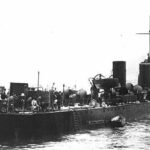 Itchen: Completed in January 1904. East Coast Destroyer Flotilla, 1st Fleet Harwich. April 1909 3rd Destroyer Flotilla, 1st Fleet. She ran aground NW of Kirkwall, 20 September 1909. Refloated, repaired Chatham. May 1912 reserve 5th Destroyer Flotilla. Early 1914 9th Destroyer Flotilla Chatham, Firth of Forth. September 1914 Scapa Flow Local Flotilla. 6 July 1917 torpedoed by UC-44 70 miles NNE of Peterhead, loss 8.
Itchen: Completed in January 1904. East Coast Destroyer Flotilla, 1st Fleet Harwich. April 1909 3rd Destroyer Flotilla, 1st Fleet. She ran aground NW of Kirkwall, 20 September 1909. Refloated, repaired Chatham. May 1912 reserve 5th Destroyer Flotilla. Early 1914 9th Destroyer Flotilla Chatham, Firth of Forth. September 1914 Scapa Flow Local Flotilla. 6 July 1917 torpedoed by UC-44 70 miles NNE of Peterhead, loss 8.
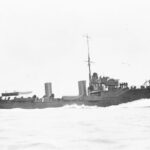 Arun: Completed February 1904. East Coast Destroyer Flotilla, 1st Fleet Harwich. 13 August 1904 under Reginald Y. Tyrwhitt, collided with Decoy off the Scilly Islands, the latter sank. April 1909 3rd Destroyer Flotilla Harwich. May 1912 5th Destroyer Flotilla reserve. Early 1914 9th Destroyer Flotilla Chatham, Firth of Forth. September Scapa Flow TD HMS Marlborough. August 1915 5th Destroyer Flotilla Mediterranean, Alexandria. Escort Eastern Mediterranean. PO 1919 sold 30 June 1920.
Arun: Completed February 1904. East Coast Destroyer Flotilla, 1st Fleet Harwich. 13 August 1904 under Reginald Y. Tyrwhitt, collided with Decoy off the Scilly Islands, the latter sank. April 1909 3rd Destroyer Flotilla Harwich. May 1912 5th Destroyer Flotilla reserve. Early 1914 9th Destroyer Flotilla Chatham, Firth of Forth. September Scapa Flow TD HMS Marlborough. August 1915 5th Destroyer Flotilla Mediterranean, Alexandria. Escort Eastern Mediterranean. PO 1919 sold 30 June 1920.
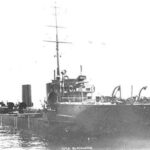 Blackwater: Completed March 1904, East Coast Destroyer Flotilla, 1st Fleet Harwich. April 1909 3rd Destroyer Flotilla. 6 April 1909 collided with merchantman SS Hero off Dungeness, English Channel, sank.
Blackwater: Completed March 1904, East Coast Destroyer Flotilla, 1st Fleet Harwich. April 1909 3rd Destroyer Flotilla. 6 April 1909 collided with merchantman SS Hero off Dungeness, English Channel, sank.
Liffey: Completed May 1905. East Coast Destroyer Flotilla, 1st Fleet Harwich. April 1909 3rd Destroyer Flotilla, May 1912 reserve 5th Destroyer Flotilla. Early 1914 9th Destroyer Flotilla Chatham, Firth of Forth. September Dover Patrol, Portsmouth. 1st Destroyer Flotilla Portsmouth November 1916. Convoy system. PO 1919, sold 30 August 1919.
Moy: Completed June 1905. East Coast Destroyer Flotilla, 1st Fleet Harwich. April 1909 3rd Destroyer Flotilla. May 1912 reserve 5th Destroyer Flotilla. Early 1914 9th Destroyer Flotilla Chatham, Firth of Forth. 16 December 1914 (under Lieutenant C. C. Naylor) sent to patrol off Hartlepool, German Battlecruiser raid, damaged by German shellfire, splinter damage, no casualties. August 1915 7th Destroyer Flotilla Humber Patrol. PO 1919 sold 27 May 1919.
Ouse: Completed September 1905. Devonport Reserve Flotilla, East Coast Destroyer Flotilla Harwich. December 1910, Chatham reserve, 3rd Destroyer, Nore. May 1912 5th Destroyer Flotilla reserve. 30 July 1914 9th Flotilla patrols Berwick-upon-Tweed, midway and Scarborough-Spurn Point. August 1915 Humber patrol. 3 May 1917 with HMS Bat misidentified and fire on C10 off Blyth, Northumberland. 28 August 1918 depth charged UC-70, spotted, damaged by Blackburn Kangaroo (246 San RAF) Runswick Bay, Yorkshire, sank. 29 September 1918 depth charged, sank UB-115 off Sunderland. PO 1919 sold 22 October 1919.
Stour: Completed December 1909, 3rd Destroyer Flotilla, 1st Fleet Harwich. May 1912 5th Destroyer reserve. 1914 9th Destroyer Flotilla Chatham. 7th Destroyer Flotilla Humber Patrol. PO 1919 sold 30 August 1919.
Test: Completed December 1909. 3rd Destroyer Flotilla Harwich. May 1912 5th Destroyer Flotilla reserve. 1914 9th Destroyer Flotilla Chatham. 16 December 1914 patrol off Hartlepool duriong the German battle-cruiser raid, undamaged, no casualties. August 1915, 7th Destroyer Flotilla Humber Patrol. PO 1919 sold 30 August 1919.
⚙ specifications Foyle 1903 |
|
| Displacement | 550 long tons (559 t) standard, 625 long tons (635 t) full load |
| Dimensions | 226 ft 6 in x 23 ft 9 in x 7 ft 9 in (69.04 x 7.24 x 2.36 m) |
| Propulsion | 2 shafts VTE, 4× Yarrow WT boiler 7,000 shp (5,200 kW) |
| Speed | 25.5 kn (47.2 km/h) |
| Range | 140 tons coal: 1,870 nmi (3,460 km) at 11 kn (20 km/h) |
| Armament 1903 | 1× QF 12-pdr 12 cwt Mark I, Mt P Mark I, 5× QF 6-pdr 8 cwt, 2× 18-in (450 mm) TTs |
| Armament 1906 | 1x QF 12-pdr 12 cwt+ 3×8 cwt mot G Mark I, 5× QF 6-pdr 8 cwt, 2× 18-in (450 mm) TTs |
| Crew | 70 officers and men |
 Thornycroft ships:
Thornycroft ships:
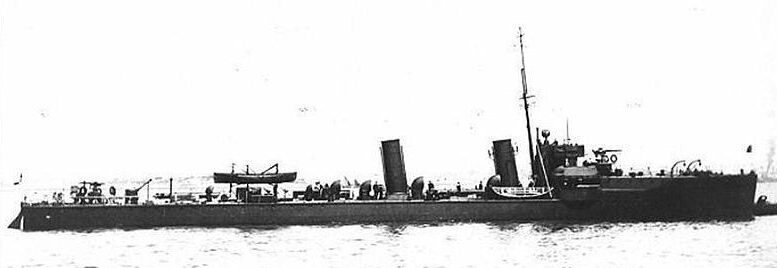
HMS Kennet as built
Featured two high funnels:
Kennet: laid down 5 December 1902, launched 4 December 1903, and completed in January 1905; sold for breaking up 11 December 1919.
Jed: laid down 27 February 1903, launched 16 February 1904, and completed in January 1905; sold for breaking up 29 July 1920.
Chelmer: laid down 11 February 1904, launched 8 December 1904, and completed in June 1905; sold for breaking up 30 June 1920.
Colne: laid down 21 March 1904, launched 21 May 1905, and completed in July 1905; sold for breaking up 4 November 1919.
Service
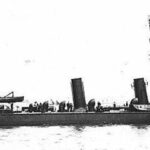 Kennet:
Kennet:
East Coast Destroyer Flotilla, 1st Fleet Harwich. 7 August 1906, was struck with Leopard in Plymouth as attempting to avoid hitting a buoy. Rudder repaired. 1909/1910 China Station. July 1914 Hong Kong TD Triumph. Tsingtao blockade. 22 August under Lt.Cdr F.A. Russel comabt with German torpedo boat S90, gunboat SMS Jaguar, shore battery. 24 November returned to Hong Kong. 5th Destroyer Flotilla Mediterranean November 1914 with Triumph, Dardanelles campaign. Skyros with HMS Wear and Jed. Fought Turkish TB Demir Hissar at Tribouki. 24 April reconnaissance round north end of Xeros Bay to Liman Bay. 25 April supported landings ANZAC Cove. 5 July 1915 Smyrna Patrol, HP Mytilene. 20 November shelled Turkish pos. at Suvla. Active there til 1918. PO 1919, sold 11 December 1919.
Jed: East Coast Destroyer Flotilla, 1st Fleet Harwich. 1909/1910 China Station, Hong Kong, TD HMS Triumph. Qingdao blockade, back to HK Hong Kong. 5th Destroyer Flotilla Mediterranean November 1914, Dardanelles campaign. 18 March 1915 rescue crew HMS Ocean. Skyros 14 April 1915 convoy 16 April, fought TB Demir Hissar. 25 April 1915 landings ANZAC Cove, feint attack on Bulair. May 1915 Gulf of Xeros, used as wireless relay for submarines, not. HMS E11. December Smyrna Patrol Cape Kaba to Smyrna, based Mytelene. 1-7 January 1916 roundup of enemy agents in Mytelene. PO 1919 sold 30 June 1920.
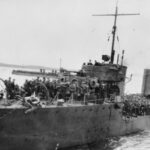 Chelmer: East Coast Destroyer Flotilla, 1st Fleet Harwich. 1909/1910 China Station. July 1914 refit, 4 September 1914, captured German collier Tannenfels, Basilan Strait, Mindanao. Fall Tsingtao, reassigned 5th Destroyer Flotilla, Mediterranean. 18 March 1915 rescue HMS Ocean. 25 April ANZAC Cove, suffered one KiA. 25 May patrolled near HMS Triumph when torpedoed, attacked the submarine and returned to rescue. PO 1919 sold 30 June 1920.
Chelmer: East Coast Destroyer Flotilla, 1st Fleet Harwich. 1909/1910 China Station. July 1914 refit, 4 September 1914, captured German collier Tannenfels, Basilan Strait, Mindanao. Fall Tsingtao, reassigned 5th Destroyer Flotilla, Mediterranean. 18 March 1915 rescue HMS Ocean. 25 April ANZAC Cove, suffered one KiA. 25 May patrolled near HMS Triumph when torpedoed, attacked the submarine and returned to rescue. PO 1919 sold 30 June 1920.
Colne: East Coast Destroyer Flotilla 1st Fleet Harwich. 11 April 1907 collided with HMS Falcon, repaired. 1909–1910 China Station. Tsingtao blockade. 24 November 1914, back to Hong Kong, redeployed to 5th Destroyer Flotilla Mediterranean November 1914, Dardanelles campaign. 3 March inshore shelling near Erenkeui, mistook and damaged by HMS Amethyst. No casualties. 18 March 1915 rescue HMS Ocean. 25 April landings ANZAC Cove and fire support. PO 1919 sold 4 November 1919.
⚙ HMS Kennet specifications |
|
| Displacement | 550 long tons (559 t) standard, 615 long tons (625 t) full load |
| Dimensions | 225 ft 9 in x 23 ft 10.5 in x 8 ft (68.81 x 7.277 x 2.4 m) |
| Propulsion | 2 shafts VTE 4× Thornycroft WT boiler 7,000 shp (5,200 kW) |
| Speed | 25.5 kn (47.2 km/h) |
| Range | 127 tons coal: 1,695 nmi (3,139 km) at 11 kn (20 km/h) |
| Armament 1902 | 1× QF 12-pdr 12 cwt Mk I, Mt P Mk I, 5× QF 6-pdr 8 cwt, 2× 18-in (450 mm) TTs |
| Armament 1906 | 1x QF 12-pdr 12 cwt+ 3×8 cwt mt G Mk I, 5× QF 6-pdr 8 cwt, 2× 18-in (450 mm) TTs |
| Crew | 70 officers and men |
 White ships:
White ships:
Two, built at J. Samuel White, Cowes, two short funnels.
HMS Ness (1905): East Coast Destroyer Flotilla, 1st Fleet Harwich. April 1909 3rd Destroyer Flotilla. May 1912 reserve 5th Destroyer Flotilla. Early 1914 9th Destroyer Flotilla Chatham Firth of Forth, September Dover Patrol. August 1915 7th Destroyer Flotilla Humber Patrol. PO 1919 sold 27 May 1919.
HMS Nith: East Coast Destroyer Flotilla 1st Fleet Harwich. April 1909 3rd Destroyer Flotilla, May 1912 reserve 5th Destroyer Flotilla. 1914 9th Destroyer Flotilla Chatham Firth of Forth, September Dover Patrol. August 1915 7th Destroyer Flotilla Humber Patrol. PO 1919 sold 23 July 1919.
⚙ specifications HMS Ness |
|
| Displacement | 535 long tons (544 t) standard, 605 long tons (615 t) full load |
| Dimensions | 229 ft 6 in x 23 ft 10 in x 10 ft (69.95 x 7.26 x 3 m) |
| Propulsion | |
| Speed | 25.5 kn (47.2 km/h) |
| Range | 135 tons coal: 1,870 nmi (3,460 km) at 11 kn (20 km/h) |
| Armament 1902 | 1× QF 12-pdr 12 cwt Mk I, Mt P Mk I, 5× QF 6-pdr 8 cwt, 2× 18-in (450 mm) TTs |
| Armament 1906 | 1x QF 12-pdr 12 cwt+ 3×8 cwt mt G Mk I, 5× QF 6-pdr 8 cwt, 2× 18-in (450 mm) TTs |
| Crew | 70 officers and men |
 HMS Arno (1911)
HMS Arno (1911)
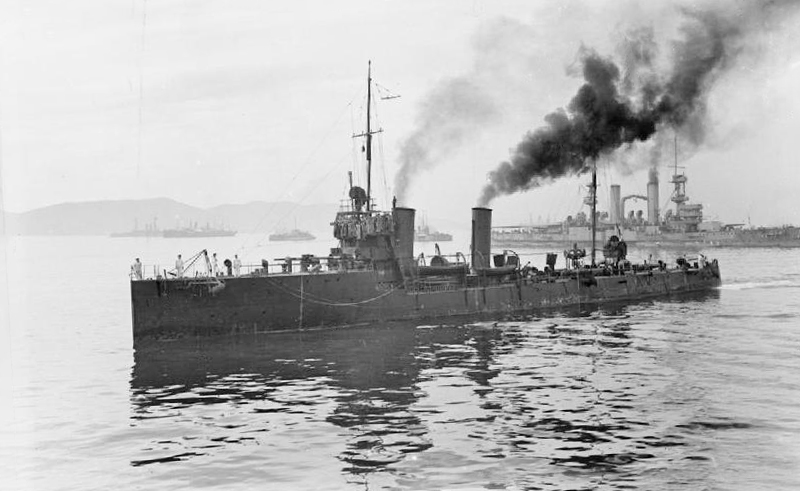
Arno had two funnels, masts, four QF 12-pdr guns, soundly built, high freeboard, tall bridge. lost off the Dardanelles after collision with Acorn-class destroyer HMS Hope, 23 March 1918.
⚙ HMS Arno specifications |
|
| Displacement | 520 long tons (528 t) |
| Dimensions | 321 ft x 23 ft 6 in x 7 ft (98 x 7.16 x 2.1 m) |
| Propulsion | |
| Speed | 28.5 kn (52.8 km/h; 32.8 mph) |
| Range | 130 long tons (132 t) fuel oil, uncknown |
| Armament | 4× 12-pdr, 3×1 18-in (450 mm) TTs |
| Crew | c70 |
Read More/Src
Books
Chesneau, Roger & Kolesnik, Eugene M., eds. (1979). Conway’s All The World’s Fighting Ships 1860–1905. London: Conway Maritime Press.
Gardiner, Robert & Gray, Randal, eds. (1985). Conway’s All The World’s Fighting Ships 1906–1921. Conway Maritime Press.
Colledge, J. J.; Warlow, Ben (2006) [1969]. Ships of the Royal Navy: The Complete Record. Chatham Publishing.
Dittmar, F.J.; Colledge, J.J. (1972). British Warships 1914–1919. Shepperton, UK: Ian Allan.
Friedman, Norman (2009). British Destroyers: From Earliest Days to the Second World War. Barnsley, UK: Seaforth Publishing.
Lyon, David (2001) [1996]. The First Destroyers. London: Caxton Editions.
Manning, T. D. (1961). The British Destroyer. London: Putnam & Co.
March, Edgar J. (1966). British Destroyers: A History of Development, 1892–1953. Official Records & Returns.
Links
https://www.worldnavalships.com/river_class.htm
https://www.battleships-cruisers.co.uk/river_class.htm
http://www.historyofwar.org/articles/weapons_river_class_destroyers.html
https://shipsproject.org/Wrecks/Wk_Foyle.html
https://www.rmg.co.uk/collections/objects/rmgc-object-66075

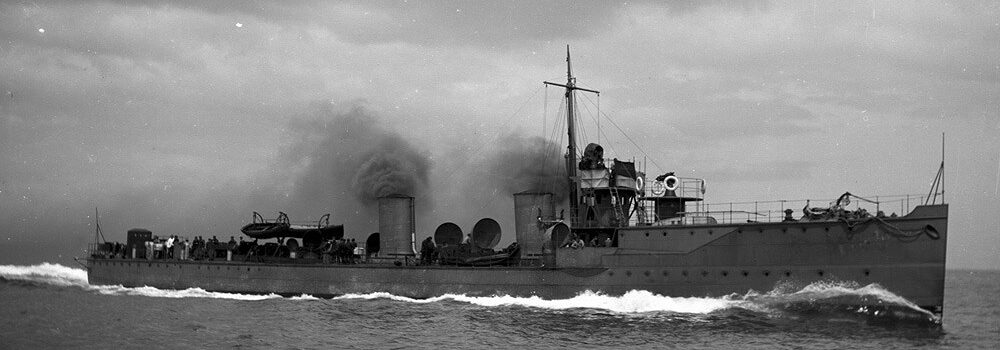
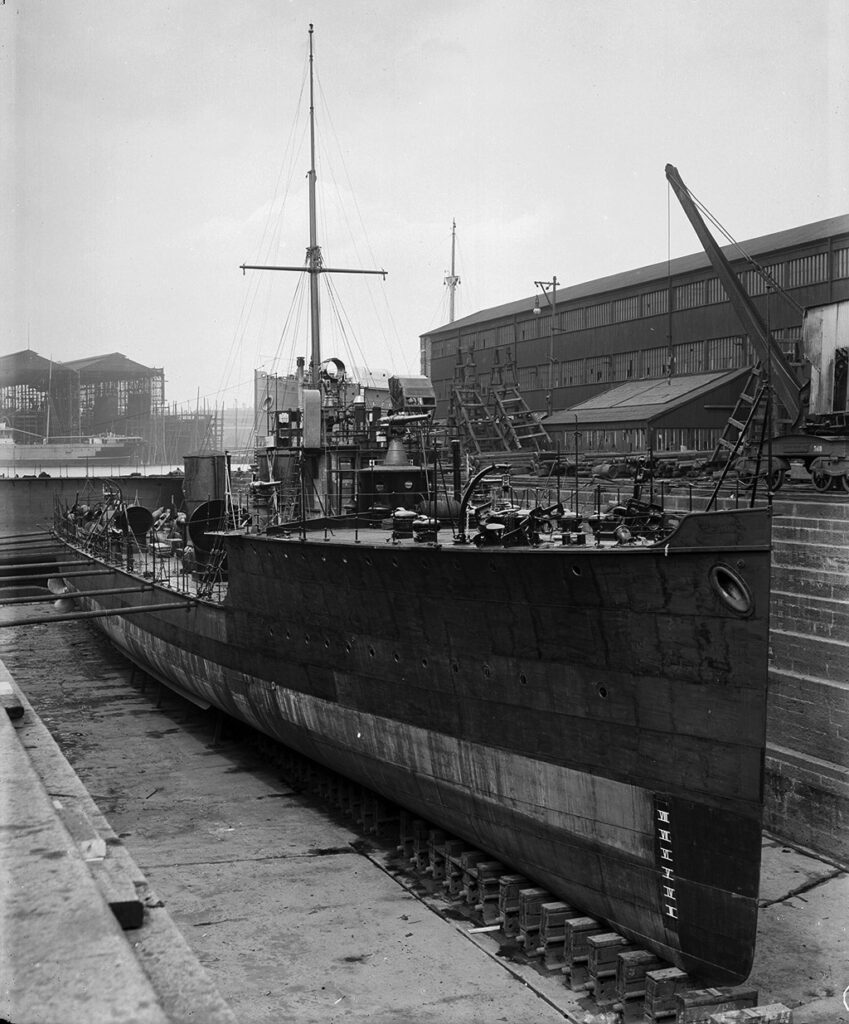
 Latest Facebook Entry -
Latest Facebook Entry -  X(Tweeter) Naval Encyclopedia's deck archive
X(Tweeter) Naval Encyclopedia's deck archive Instagram (@navalencyc)
Instagram (@navalencyc)





 French Navy
French Navy Royal Navy
Royal Navy Russian Navy
Russian Navy Armada Espanola
Armada Espanola Austrian Navy
Austrian Navy K.u.K. Kriegsmarine
K.u.K. Kriegsmarine Dansk Marine
Dansk Marine Nautiko Hellenon
Nautiko Hellenon Koninklije Marine 1870
Koninklije Marine 1870 Marinha do Brasil
Marinha do Brasil Osmanlı Donanması
Osmanlı Donanması Marina Do Peru
Marina Do Peru Marinha do Portugal
Marinha do Portugal Regia Marina 1870
Regia Marina 1870 Nihhon Kaigun 1870
Nihhon Kaigun 1870 Preußische Marine 1870
Preußische Marine 1870 Russkiy Flot 1870
Russkiy Flot 1870 Svenska marinen
Svenska marinen Søværnet
Søværnet Union Navy
Union Navy Confederate Navy
Confederate Navy Armada de Argentina
Armada de Argentina Imperial Chinese Navy
Imperial Chinese Navy Marinha do Portugal
Marinha do Portugal Mexico
Mexico Kaiserliche Marine
Kaiserliche Marine 1898 US Navy
1898 US Navy Sovietskiy Flot
Sovietskiy Flot Royal Canadian Navy
Royal Canadian Navy Royal Australian Navy
Royal Australian Navy RNZN Fleet
RNZN Fleet Chinese Navy 1937
Chinese Navy 1937 Kriegsmarine
Kriegsmarine Chilean Navy
Chilean Navy Danish Navy
Danish Navy Finnish Navy
Finnish Navy Hellenic Navy
Hellenic Navy Polish Navy
Polish Navy Romanian Navy
Romanian Navy Turkish Navy
Turkish Navy Royal Yugoslav Navy
Royal Yugoslav Navy Royal Thai Navy
Royal Thai Navy Minor Navies
Minor Navies Albania
Albania Austria
Austria Belgium
Belgium Columbia
Columbia Costa Rica
Costa Rica Cuba
Cuba Czechoslovakia
Czechoslovakia Dominican Republic
Dominican Republic Haiti
Haiti Hungary
Hungary Honduras
Honduras Estonia
Estonia Iceland
Iceland Eire
Eire Equador
Equador Iran
Iran Iraq
Iraq Latvia
Latvia Liberia
Liberia Lithuania
Lithuania Mandchukuo
Mandchukuo Morocco
Morocco Nicaragua
Nicaragua Persia
Persia San Salvador
San Salvador Sarawak
Sarawak Uruguay
Uruguay Venezuela
Venezuela Zanzibar
Zanzibar Warsaw Pact Navies
Warsaw Pact Navies Bulgaria
Bulgaria Hungary
Hungary

 Bundesmarine
Bundesmarine Dutch Navy
Dutch Navy Hellenic Navy
Hellenic Navy Marina Militare
Marina Militare Yugoslav Navy
Yugoslav Navy Chinese Navy
Chinese Navy Indian Navy
Indian Navy Indonesian Navy
Indonesian Navy JMSDF
JMSDF North Korean Navy
North Korean Navy Pakistani Navy
Pakistani Navy Philippines Navy
Philippines Navy ROKN
ROKN Rep. of Singapore Navy
Rep. of Singapore Navy Taiwanese Navy
Taiwanese Navy IDF Navy
IDF Navy Saudi Navy
Saudi Navy Royal New Zealand Navy
Royal New Zealand Navy Egyptian Navy
Egyptian Navy South African Navy
South African Navy






























 Ukrainian Navy
Ukrainian Navy dbodesign
dbodesign